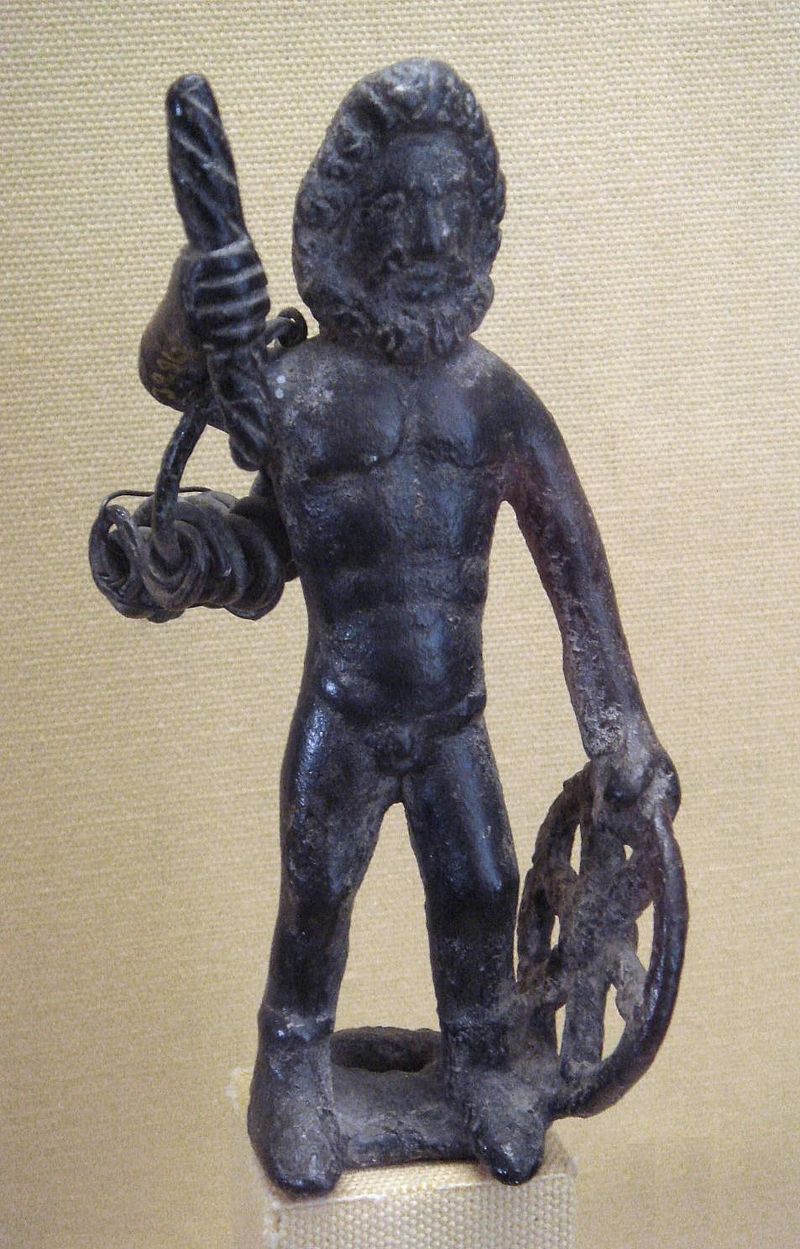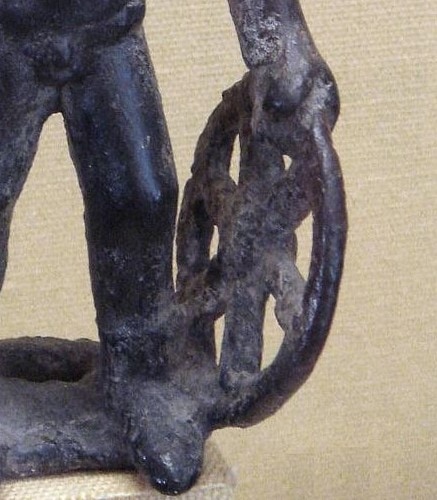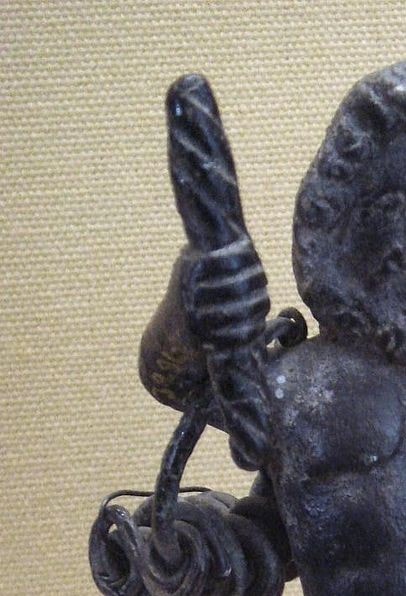
Table of Contents
Known by many names, Taranis was an important deity worshipped in the Bronze Age throughout most of Europe. He was originally a Celtic sky god who embodied the mystical elements of thunder and storms, often represented by a thunderbolt and a wheel. Taranis’ history is archaic and all encompassing, a deity whose importance crossed cultures and lands throughout the centuries.
Who is Taranis?

All across Celtic and pre-Celtic Europe, from Gaul to Britain, across the majority of Western Europe and east to the Rhineland and the Danube regions, a deity existed which was associated with thunder and accompanied by the symbol of a wheel, now commonly known as Taranis.
While very few written historical references mention this deity, the symbolism linked to him shows he was respected and revered amongst all Celtic pantheons. Many representations of a bearded figure with a thunderbolt in one hand and a wheel in the other have been recovered from the area of Gaul, all referencing this important deity who was said to have control over storms, thunder, and the sky.
The name was solidified as Taranis by Lucan, a Roman poet, who in his 1st century epic poem ‘Pharsalia’ mentions a triad of deities – Esus, Toutatis, and Taranis, who were all extremely important to the Celts of Gaul and their belief system.
Lucan also mentions a cult which is solely devoted to Taranis in Gaul, yet the origin of this deity may have begun long before Rome’s involvement in Gaul. Later when influenced by Roman art, Taranis became fused with the Roman deity Jupiter.
The Origin and Etymology of Taranis
The name Taranis originates from the Indo-European root ‘Taran’, which is based on the proto-Celtic ‘Toranos’ literally meaning “thunderer”. The name has many variations including Taranucno, Taruno, and Taraino, all of which refer to the same deity who was worshipped across Europe.
- Inscriptions made in reference to this deity from the Roman era have been discovered in Scardona, Croatia, such as ‘Iovi Taranucno’.
- Two dedications are found in Rhineland also referring to ‘Taranucno’.
- The name has many cognates in many Celtic languages including Britain and Ireland. In old-Irish language, thunder is ‘Torann’ (thunder or noise), and there Taranis was known as Tuireann.
- In old Breton and Welsh ‘Taran’ also meant (thunderer or noise).
- In the region of Gaul, the name most used was ‘Taram’.
Each of these similar but unique names were used in respect to the same deity of the sky associated with the power of thunder and lighting.
There is some evidence to suggest the Picts of Northern Scotland, who are considered a pre-Celtic race of Britain at the time of Rome’s control over southern England, worshipped Taranis. In the list of the Pictish kings there was an early king, possibly even the founder of the Pictish confederacy or dynasty, named Taran. Clearly, this important figure shared his name with the respected Taranis of Gaul.
The thunderbolt is historically the Picts most carved symbol. Since they were often accompanied by two circles or wheels, it can be deduced that the Picts had a strong connection to Taranis, as did many cultures of this part of the world.
Symbols of Taranis
Many archaeological items representing Taranis have been discovered from the Bronze Age across the Celtic world.
Wheel of Taranis
The most common symbol associated with Taranis was the sacred wheel. Thousands of votive wheels, often called rouelles, have been discovered by archaeologists around the greater area of Belgic Gaul. Many of these votive wheels were once used as amulets to ward against evil. They were usually made of bronze and had four spokes like arcane sun crosses; they later evolved to have six or eight spokes.

A bronze hoard from Reallons in Southwest France dated 950 B.C. revealed three miniature wheel pendants. Dechelette, a French scholar, states that this type of item has been recovered all over France. The wheel has also been found on several extravagant items, such as one of the most famous representations – the Gundestrup Cauldron. This cauldron, found in Denmark, displays sacred wheels that accompanies many other Celtic symbols and deities.

In Le Chatelet, France a bronze figurine was discovered which dated back to the 2nd century B.C. that shows a deity holding a thunderbolt and wheel. This deity became known as the Celtic wheel god and had connections to the sky and its storms.
In Newcastle in the north of England, stone molds were discovered that bore the shape of the wheel; from this mold small wheel votives or broaches would have been made in bronze.
As far west as Denmark and as east as Italy, votive wheels were found dating from the bronze age, which suggests the sacrosanctity of the symbol as a widespread phenomenon throughout Europe.
The ‘Wheel of Taranis’ can be found within Celtic and Druidic cultures. In contradiction to its common name the ‘Solar Wheel’, this symbol was not associated with the sun, but in fact represented the powers of the universe as a whole and the mobility of the planetary cycles. It is also a common symbol appearing throughout Greek and Vedic cultures of the far east.
The wheel, with its many representations, is also connected to the chariot, and more specifically the chariot of the celestial gods. The connection between the chariot and stormy skies could be in the sound of lightning, a.k.a. thunder, which resembles the loud sound of a chariot moving along a road.
Thunderbolt

The power of storms was well known in the Celtic world, and Taranis’ strength and importance is apparent in his connection with that power. This is well represented by the lightning bolt which often accompanies depictions of Taranis in Gaul, similar to the later Roman Jupiter.
Jupiter-Taranis
During the Roman occupation of Britain and Gaul, the worship of Taranis became associated with the Roman deity Jupiter. The two share many attributes. Both are represented by the sky and its storms.
In Chester, England there is an altar with the Latin words ‘Jupiter Optimus Maximus Taranis’ accompanied by the symbolic wheel. This inscription by a Roman from Spain, or Hispania, clearly indicates association to a hybrid deity we may call Jupiter-Taranis.
More evidence of the unified deity can be found in a commentary on Lucan’s work by an unknown author found in Berne, Switzerland in which Taranis is equated with the Roman sky god Jupiter.
Jupiter was originally represented symbolically through the eagle and the thunderbolt; the wheel was never included. However, after the Romanization of Britain and Gaul, Jupiter was often shown with the sacred wheel. Scholars have concluded that both deities were a hybrid, forever in connection to each other.
Relevance of Taranis Today
The archaic gods of the Celtic and Roman worlds are not often thought of in modern culture. However, their tales and legends live on in the most surprising ways. Whether they realize it or not, people today are still as interested in the stories of the gods as they were thousands of years ago.
Weapons of war are often associated with these all-powerful deities. For example, a British combat drone system developed by BAE systems was named in honor of Taranis and his control of the skies.
In pop culture, Taranis is often mentioned in books and television series focused on superheroes or people with exceptional power and connection to the natural world. Marvel is a multibillion-dollar company which has based many of its stories on the legends of these ancient deities.
Conclusion
The importance of Taranis as a Celtic god could have easily been forgotten. With very little written history, his story lives on solely in the many archeological artifacts with which he is associated. The wheel and the thunderbolt seen across cultures remind the modern scholar of this sky god’s extensive reach, as well as the importance and respect for the natural world amongst the arcane people who worshipped him.








